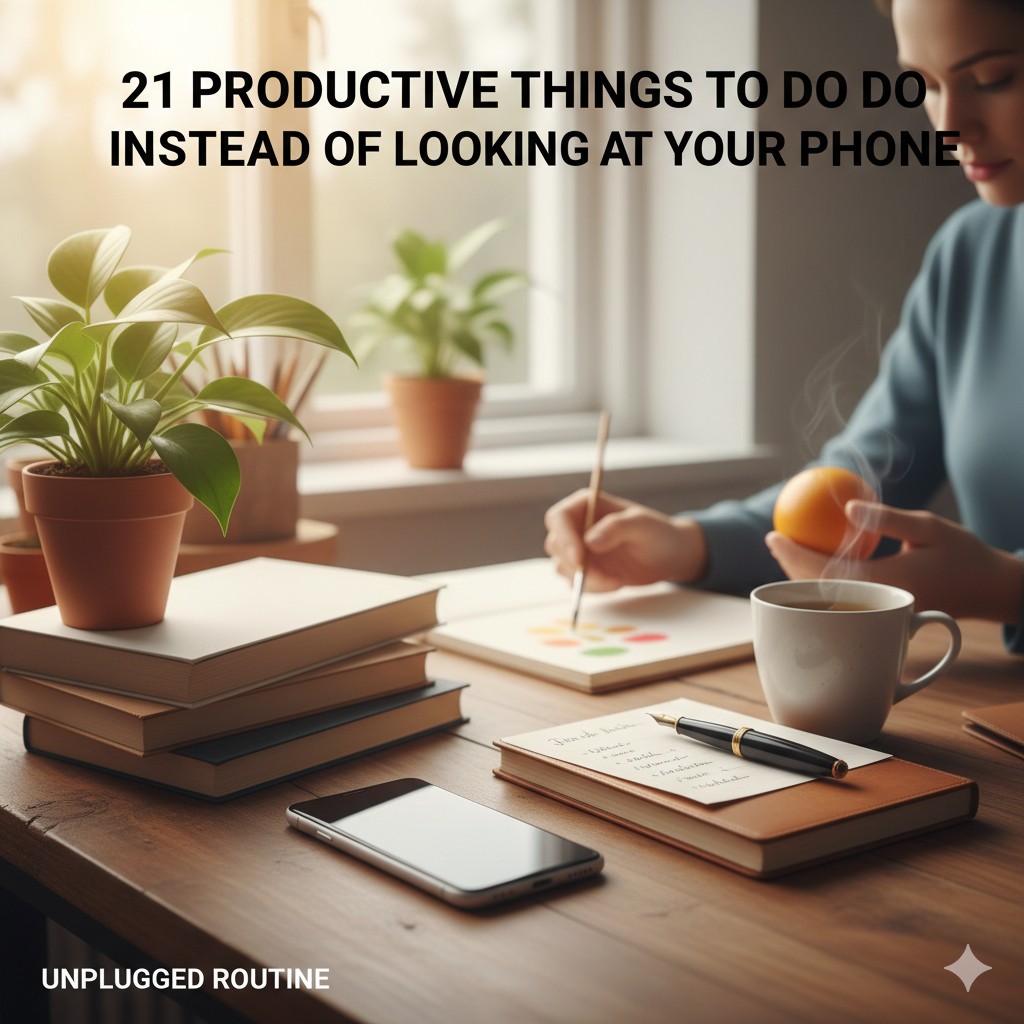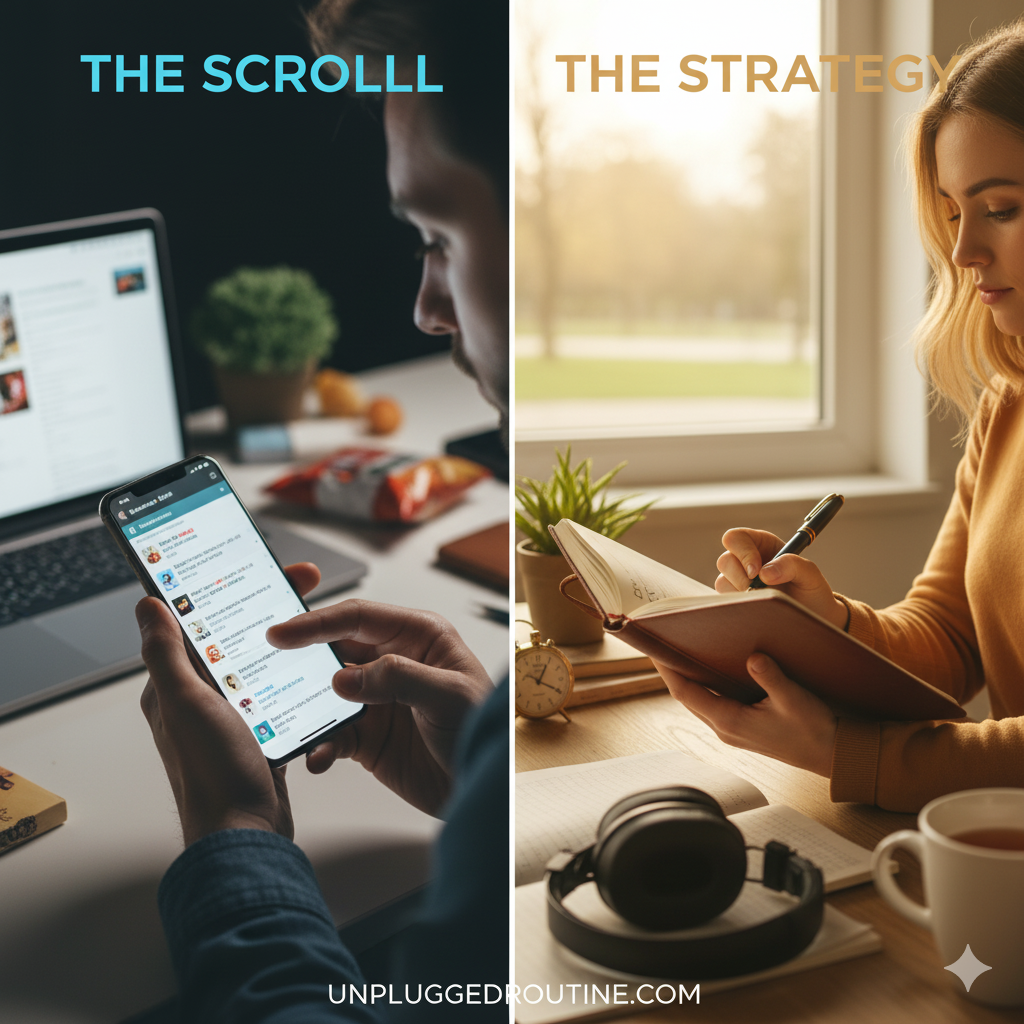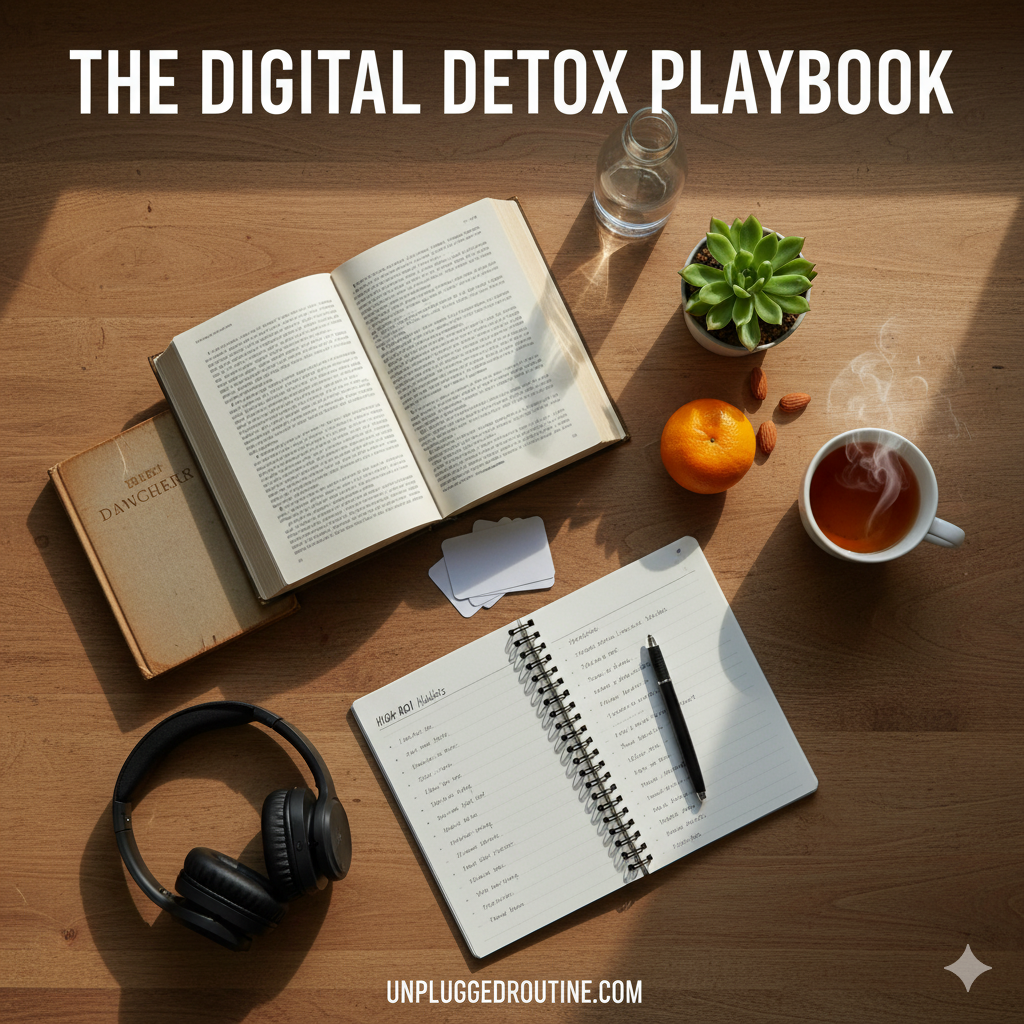Let’s talk about the 15-minute trap. You know it well: you pick up your phone to check the time or verify one small fact, and before you know it, an entire quarter-hour has vanished. You didn’t accomplish anything, you probably feel a little anxious, and your brain is now fried from a chaotic mix of news headlines, urgent texts, and Instagram filters.
For the modern American professional, parent, and entrepreneur, that “wasted” time is not just minutes—it’s high-value mental real estate.
The truth is, your lack of focus isn’t a personality flaw; it’s a habit problem. Your brain has been conditioned to crave the dopamine hit of the screen. The only way to break the cycle isn’t through willpower alone, but by replacing the bad habit with a better, more rewarding one.
This comprehensive guide gives you 21 Productive Things to Do Instead of Looking at Your Phone, transforming those moments of digital distraction into real, measurable progress toward your biggest goals. This is your playbook for reclaiming your focus, boosting your productivity, and winning back your day, one micro-moment at a time.
Table of Contents
Why Screen Swapping is Your #1 Productivity Hack (For the US Market)
In the US, time is money, and our culture values visible, results-driven efficiency. The power of this “screen-swapping” technique isn’t about doing less; it’s about making micro-investments that yield a high return on investment (ROI).
The average person checks their phone 80-150 times per day. If you replace just ten of those checks with a 60-second intentional task, you’ve suddenly found an extra 10 minutes of high-quality, focused time. Over a week, that’s an hour of self-improvement.
This guide is organized into four key areas of personal growth—Professional, Mental, Physical, and Social—so you can pick the high-impact activity you need most in that moment.

Section 1: Sharpen Your Career & Financial Edge
Use your idle moments (waiting for coffee, before a meeting starts) to perform high-leverage tasks that move your professional life forward.
1. The 60-Second Goal Review
Instead of opening your email app, open your physical planner or a dedicated “Big 3” digital note. Review the three most critical tasks you must complete today.
- Why it works: This is an instant mental reset. It forces your brain to prioritize, protecting you from wasting the first hours of the day on low-value, urgent requests.
2. Learn a Micro-Skill on a Flashcard
Keep physical index cards with 3-5 key facts, vocabulary, or formulas you’re trying to master (e.g.,5 Spanishphrases,3 marketing terms, a coding shortcut). Flip through one card.
- Why it works: You harness the power of spaced repetition. You build valuable skills through consistent micro-learning, eliminating the excuse that you don’t have time to learn.
3. Archive/Delete 10 Non-Essential Emails
Focus solely on clearing out promotional newsletters, junk mail, or notifications. Do not open or respond to anything.
- Why it works: You attack Inbox Anxiety. By preventing the buildup of digital clutter, you reduce a massive source of background stress and maintain a sense of control.
4. Organize a Digital Folder (The 2-Minute Tidy)
Go into your computer’s “Downloads” folder, your cloud storage, or your desktop and organize/delete 5-10 files.
- Why it works: Digital chaos mirrors mental chaos. Taking 120 seconds to impose order on your files clears your digital workspace, which frees up mental energy.
5. Review Your Financial Tracker
Open your budgeting app (Mint, You Need A Budget, etc.) or check your high-level investment dashboard. You don’t need to make a transaction—just look at the numbers.
- Why it works: This cultivates financial mindfulness. Regular, brief check-ins make financial management less intimidating and keeps you actively engaged with your money goals.
6. Write a “Brain Dump” of Obstacles
Grab a notepad and rapidly write down (bullet point style) all the specific things currently blocking your progress (work, personal, health). Don’t solve them, just list them.
- Why it works: Externalizing stress is the first step to conquering it. It pulls the swirling thoughts out of your head and onto the page, creating clarity.
Section 2: Reset Your System (Mindful & Physical Quick-Fixes)
These activities are designed to interrupt the stress response caused by screen time and inject immediate calm and physical energy.
7. Perform the 4−7−8 Breathing Technique
Inhale quietly through the nose for a count of 4; hold the breath for a count of 7; exhale completely through the mouth for a count of 4. Repeat 3-4 times.
- Why it works: This breathing method directly activates your parasympathetic nervous system, acting as an instant anti-anxiety button that slows your heart rate.
8. The 5-Senses Grounding Exercise
Look around and name 5 things you see, 4 things you can touch, 3 things you can hear, 2 things you can smell, and 1 thing you can taste.
- Why it works: This technique immediately pulls your mind out of worry (which lives in the past/future) and anchors you firmly in the present, reducing overthinking.
9. Hydrate and Supplement Check
Stand up and walk to get a full, fresh glass of water, or take your scheduled vitamin/supplement.
- Why it works: Dehydration often masks itself as brain fog and fatigue. A quick, intentional hydration break is a non-negotiable step toward peak cognitive performance.
10.3-Minute Focused Stretching
Do a seated spinal twist, shoulder rolls, and neck circles. Focus only on releasing the tension caused by your posture.
- Why it works: It addresses the physical impact of sitting (the “computer hunch”), boosting blood flow and signaling to your body that you are alert, not sedentary.
11. Practice “Loving-Kindness” (Metta) Meditation
Silently repeat a few phrases of goodwill: “May I be safe. May I be happy. May I be healthy. May I live with ease.” Spend 60 seconds on yourself, then 60 seconds on someone else.
- Why it works: This simple practice switches your focus from internal stress to compassionate connection, proven to increase positive emotions and reduce self-criticism.
12. Adjust Your Environment and Ergonomics
Check your chair height, push your feet flat on the floor, and pull your monitor 18-24 inches away from your face.
- Why it works: Optimizing your workspace is a foundational element of sustainable productivity. It reduces strain, preventing headaches and back pain before they start.
🎁 Featured Resource: Your 5-Minute Focus Tool
If the idea of writing a full journal entry feels too daunting, we highly recommend a structured tool designed for instant gratitude and focus. The 5-Minute Journal uses simple, guided prompts to help you achieve clarity in 300 seconds or less—the perfect swap for that scrolling urge.

Section 3: High-Value Home & Social Prep
Use your phone-free moments to improve your relationships, environment, and personal routines.
13. Implement the “One-Minute” Rule
If a task takes less than 60 seconds to complete, do it immediately. Put the plate in the dishwasher, hang up the jacket, or throw away the empty packaging.
- Why it works: This prevents “small mess syndrome,” where numerous tiny, unaddressed tasks create an overwhelming sense of domestic burden. It’s continuous, low-effort cleaning.
14. Write a Physical Note or Letter
Keep a stack of blank cards and an address book nearby. Write a quick, genuine thank-you, congratulatory, or “thinking of you” note to one person.
- Why it works: In a digital world, receiving a physical note is a high-impact, memorable gesture. It strengthens your most important relationships and requires focused, meaningful effort.
15. Pre-Plan the Next Meal
Look at your fridge and pantry and quickly decide what you will eat for the next meal (or dinner tonight). If you need to thaw something, pull it out.
- Why it works: It eliminates decision fatigue at the end of a long, stressful day. Having a plan makes healthy eating easier and saves you from the inevitable late-day takeout craving.
16. 5-Minute Visual Declutter
Use a laundry basket or box to quickly gather every item in one room that doesn’t belong and remove it. The goal is to make the room visually clean.
- Why it works: Clutter saps mental energy. This quick burst of organization creates an immediate sense of peace and accomplishment in your immediate environment.
17. Deepen a Connection with a Loved One
Engage 100% with a person near you—your spouse, child, or roommate. Ask an open-ended question (e.g., “What’s the most interesting thing you thought about today?”). Do not check your phone while they answer.
- Why it works: True presence is rare. This intentional focus dramatically improves the quality of your relationships by making the other person feel truly seen and heard.
18. Tend to Your Plants or Pets
Water your plants, repot a small succulent, or spend 5 minutes grooming or playing with your pet.
Section 4: Creative & Future-Focused Investment
These alternatives use your spare mental capacity to generate ideas, plan the future, or engage your creative side—activities the phone often stifles.
19. Generate 5 Future Project Ideas
Grab a piece of paper and write down 5 ideas for a side hustle, a personal project (e.g., remodel, garden), or a creative pursuit (e.g., book outline, course concept). No filtering allowed.
- Why it works: Distraction kills creativity. This simple action forces your brain to switch into generative, innovative mode, capitalizing on a moment of non-stimulated thought.
20. Read a Chapter of a Physical Book
Keep a physical, non-work-related book where your phone would usually be (bedside, desk). When you reach for your phone, grab the book instead.
- Why it works: Reading a physical book exercises sustained focus—a muscle that is severely weakened by scrolling. It improves memory, comprehension, and vocabulary.
21. Learn an Analogue Skill (Knot,5-Minute Sketch)
Spend 3 minutes practicing a skill that requires your hands and has no screen (e.g., tying a proper sailing knot, learning to shuffle cards, doing a quick sketch of an object on your desk).
- Why it works: Engaging in analogue activities stimulates different parts of your brain, providing a powerful, hands-on sense of mastery and satisfaction that doomscrolling can never deliver.

The Compounding Power of Small Decisions
The choice to engage in 21 Productive Things to Do Instead of Looking at Your Phone is more than just a trick to save time. It’s a fundamental shift in mindset.
The digital noise of the world is constantly trying to capture your attention and monetize your focus. Every time you consciously select a high-ROI activity from this list, you are not just getting one thing done—you are building the core neurological foundation of attention, patience, and intentional living.
Small, positive changes, performed consistently, always lead to a massive outcome. Stop treating your idle moments as empty voids that need to be filled by a screen. Start seeing them as investment opportunities for the person you want to become.
Take Action Now: Your 7-Day Challenge
Ready to take control?
- Print this list: Keep it near your desk, bedside table, or next to your phone charger.
- Identify your trigger: What are the three times a day you always check your phone (e.g., first thing in the morning, while waiting for the elevator, right before bed)?
- Choose your swap: Commit to replacing the scroll with one item from this list at each of those three times for the next 7 days.
Ready to build a life of intention, focus, and genuine presence? Join the movement and explore our definitive Digital Detox Toolkit right here on unpluggedroutine.com!